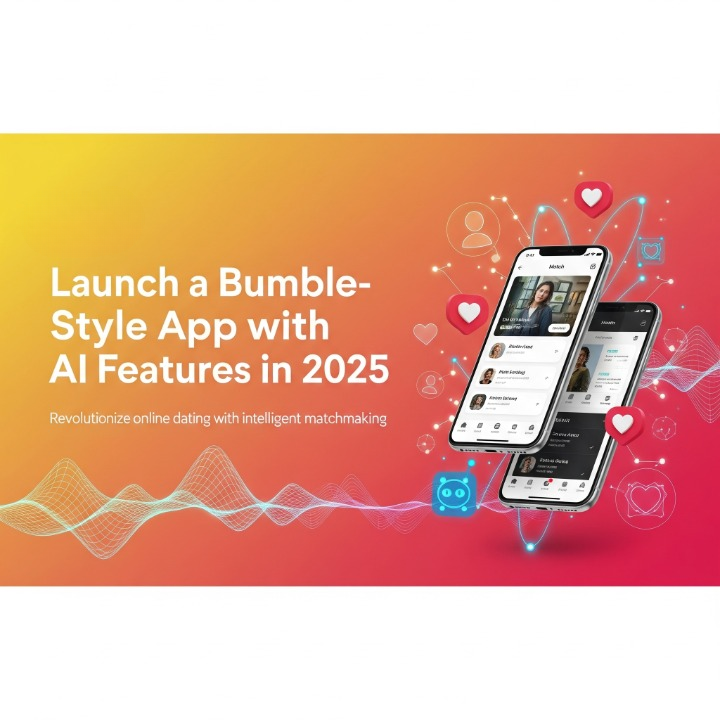Launch a Bumble-Style App with AI Features in 2025

I want to build a women-first, swipe-based dating app that feels modern, safe, and smart. You’re in the right place. In 2025, users expect more than a swipe. They want trust, control, and meaningful matches. They also want speed and fun. That’s where AI shines helping you match better, moderate safer, and scale faster. And yes, choosing the right Dating App Development company early can save months of time and a lot of money.
Below, you’ll get a full guide from product vision to launch and growth. It includes 24 detailed steps, sample tech stacks, cost and timeline tips, and a clear plan to ship an MVP and keep improving it. We’ll also show where Generative AI Integration Services add the most value without harming user trust.
What “Bumble-Style” Means in 2025
“Bumble-style” means a women-first approach where matches only enable conversation when the woman messages first (in heterosexual matches). It also means strong safety tools, respectful design, and features that reduce spam and pressure. In 2025, the bar is even higher. Users expect:
-
Clear control over who sees them and how.
-
Real safety features that actually work, not just a badge.
-
Useful AI that suggests better matches and friendly icebreakers.
-
Human support when needed, with fast responses.
Your app should take these serious values and mix them with delight. Think fast swipes, smart recommendations, gentle prompts, and easy reporting.
Why a Dating App Development Company Matters
A seasoned Dating App Development company brings patterns that work, warnings about what breaks, and code libraries you can trust. They know how to structure matching systems, real-time chat, and in-app purchases. They also know how to pass app store reviews and scale push notifications. Most of all, they help you avoid reinventing the wheel so you focus on brand, safety, and community.
Where Generative AI Integration Services Fit
Generative AI Integration Services let you build features users feel right away:
-
Profile assistant: helps users write a short, honest bio in their own tone.
-
Conversation starters: offers kind, context-aware openers to reduce awkwardness.
-
Safety prompts: flags risky messages before they’re sent and nudges users to be respectful.
-
Fraud signals: catches fake accounts using patterns in text, images, and behavior.
Use generative AI as a coach and a helper not as a puppet. Keep users in control and show them how AI is used.
MVP vs. Full Product: A Smart Roadmap
You don’t need everything on day one. A strong MVP has:
-
Signup, profile, swipe, match, chat, and report.
-
Basic AI for onboarding help and light moderation.
-
Core analytics to watch retention and match quality.
Then you ship weekly improvements. Add voice/video, boost packs, and advanced filtering after you confirm core fit. This short loop lowers risk and keeps you close to real users.
24-Step Blueprint to Launch
Step 1: Pick a Niche That Cares
Target a clear group of young professionals, new-in-city movers, pet lovers, or language learners. A niche makes your marketing cheaper and your product sharper. It also reduces noise and helps your AI match on the signals that matter to that community.
Step 2: Build Simple Personas
Define 2–3 personas with age, goals, fears, and deal-breakers. Use short, plain-language summaries. Focus on why they swipe, why they ghost, and what makes them feel safe enough to start a chat or a date.
Step 3: Clarify Your Value Proposition
Write one sentence that says what you are and why you’re different. For a Bumble-style app, it could be: “Respectful matches, women-first rules, and AI that helps you break the ice.” Keep it visible onboarding and on your website.
Step 4: Respect Privacy and Law
Collect the minimum data to deliver value. Explain why you need each item. Give in-app access controls and a clear “delete my data” path. Store sensitive data securely and encrypt it in transit and at rest.
Step 5: Choose Monetization Early
Paid boosts, super likes, premium filters, read receipts, or weekly “match passes” pick 2–3 to start. Price simply. Let users try features with limited free credits so they see the value before paying.
Step 6: Lock Core Features
Your core set: profile creation, swipe, match, chat, and reporting. Make each path fast and obvious. Don’t load the MVP with heavy extras. Nail the basics first.
Step 7: Design Stress-Free Onboarding
Let users sign up with a phone or email. Show a short checklist: add photos, set interests, and set boundaries (distance, age, pronouns). Use tooltips and microcopy to make each step clear and kind.
Step 8: Put Safety First
Add phone verification, optional government ID verification (where policy allows), and photo liveness checks that are explained and consented. Give quick access to Block, Unmatch, and Report with clear categories and follow-up.
Step 9: Plan the Matching Brain
Start with simple signals: distance, age range, basic interests. Add AI-based affinity scoring later. Keep the model explainable to your team. Use A/B tests to confirm if AI improves match-to-chat rates.
Step 10: Add an AI Profile Coach
Use Generative AI Integration Services to suggest profile lines based on a user’s interests and tone. Always let users edit. Show a label: “AI-suggested. You’re in control.” This builds trust and reduces writer’s block.
Step 11: Make Chats Easier with AI
Offer 3–5 friendly openers tied to shared interests (“You both like trekking favorite trails?”). Let users save and tweak them. Add a toggle to turn suggestions off.
Step 12: Support Voice and Video
Short video intros reduce catfishing and boost trust. Keep clips short and let users retake them. In-chat voice notes help people express tone. Offer report tools inside calls.
Step 13: Use Smart Geolocation
Start with city-level targeting and adjustable distance filters. Offer “Travel Mode” so users can set a city before they arrive. Cache nearby candidates to make swiping instant.
Step 14: Localize & Be Inclusive
Support common languages for your market. Respect names, pronouns, and relationship options. Provide a “share limited info” mode for privacy-sensitive users.
Step 15: Keep It Fast
Aim for sub-200ms API response for critical paths. Preload media. Use a content delivery network (CDN). Optimize image sizes automatically on upload.
Step 16: Shape Your Data Layer
Track events like Build funnels for signup → profile complete → first swipe → first match → first chat.
Step 17: Create a Design System
Set rules for buttons, cards, spacing, typography, and states. Your UI should feel soft, safe, and clear. Use warm microcopy and empty-state illustrations that invite action.
Step 18: Add Gentle Gamification
Use streaks or “intent prompts” sparingly. Reward respectful behavior, not spam. Give badges for verified photos, complete profiles, or kind messaging.
Step 19: Instrument Analytics from Day 1
Add dashboards for daily active users (DAU), day-1/7/30 retention, match rate, match-to-chat rate, and report rate. Set alerting for spikes in reports or dips in message quality.
Step 20: Prime Marketing Early
Build your waitlist page before alpha. Offer early access codes and referral perks. Share behind-the-scenes stories and safety principles to build trust with your niche.
Step 21: Pass App Store Reviews
Follow photo and content rules. Add a “Report” path from the profile screen. Explain your data use in simple language. Test purchase flows on both iOS and Android.
Step 22: Prepare Support Workflows
Create macros for common issues: login fails, payment issues, report follow-ups, and unmatch disputes. Track SLA targets and response times.
Step 23: Roll Out in Stages
Start with a small city or a single university network. Watch match quality and support load. Fix friction, then widen the radius.
Step 24: Build Growth Loops
Use tasteful invites and “vouch for a friend” features. Offer small credits or boosts for verified referrals. Keep notifications useful, not noisy.
Must-Have AI Features in 2025
-
AI onboarding coach: helps new users complete profiles quickly and well.
-
Contextual icebreakers: suggests openers based on shared interests.
-
Toxicity and spam filters: warn before sending or receiving harmful messages.
-
Image and video checks: detect nudity, fakes, or duplicate spam at upload time.
-
Smart recommendations: rank candidates by likely mutual interest, not just distance.
Each AI feature should be opt-in or easy to turn off, with clear disclosures.
Tech Stack Snapshot
Frontend (Mobile):
-
Native iOS (Swift) and Android (Kotlin) or cross-platform (Flutter/React Native).
-
Local cache for fast swipes and offline profile editing.
-
Accessibility: large tap targets, screen reader labels, high-contrast themes.
Backend & APIs:
-
Node.js, Go, or Python with REST/GraphQL.
-
Real-time chat via WebSockets.
-
Media storage on cloud with automatic resizing and moderation hooks.
Data & AI:
-
Managed databases (PostgreSQL for relational; Redis for queues; vector DB for AI embeddings).
-
Model hosting for moderation and recommendation.
-
Feature store to track interests, behavior vectors, and safety scores.
DevOps:
-
CI/CD pipelines, blue-green deploys, canary releases.
-
Observability: logs, metrics, traces, error dashboards.
-
Rate limiting and WAF to handle abuse.
Security:
-
OAuth2/OpenID Connect, short-lived tokens, device fingerprinting.
-
Encryption in transit and at rest.
-
Regular pen tests and dependency checks.
Cost & Timeline: What to Expect
-
Discovery (2–4 weeks): research, flows, wireframes, and technical plan.
-
MVP Build (10–16 weeks): core features, basic AI, analytics, and store submission.
-
Beta (4–6 weeks): staged rollout, fixes, performance tuning.
-
Post-launch: continuous improvement every 1–2 weeks.
Costs vary by team size and scope. The biggest drivers are real-time chat, AI features, and moderation workflows. Reuse proven modules to save time.
Monetization Models That Work
-
Subscriptions: unlimited likes, advanced filters, read receipts.
-
Consumables: boosts, super likes, profile spotlights.
-
Bundles: weekly “date night” packs with multiple perks.
-
Premium verification: enhanced trust badge and priority ranking.
-
Partnerships: local events, safe-date perks, or gift cards (with care).
Test pricing with experiments. Show clear value before asking for payment.
UX Principles for Trust & Safety
-
Women-first defaults: give control over who can message first.
-
Boundaries upfront: let users set deal-breakers and limit who can view them.
-
One-tap reporting: always visible, never hidden.
-
Calm notifications: helpful, not pushy.
-
Honest labels: mark AI-suggested text and edits.
Compliance, Ethics, and Transparency
-
Consent: ask before using images for verification or models.
-
Explainability: tell users how recommendations work in simple terms.
-
Right to delete: make data deletion fast and traceable.
-
Age gates: robust age checks and protections for minors (no entry).
-
Fairness: test models for bias. Adjust if certain groups get worse outcomes.
ASO & SEO Plan for Launch
App Store Optimization (ASO):
-
Title and subtitle that highlight safety and women-first design.
-
Screenshots with short captions: “AI icebreakers,” “Verified profiles,” “Report tools.”
-
Localized keywords for your target cities.
SEO:
-
Landing pages for niche communities and cities.
-
Blog posts on first-message tips, safe-date guides, and success stories.
-
Technical basics: fast page speed, structured data, clean sitemaps.
A 10-Step Launch Playbook
-
Closed alpha with friends-of-team to find crashes fast.
-
Invite-only beta in a small city or campus.
-
Daily triage for crashes, payment bugs, and high-severity reports.
-
Targeted influencer pilots that focus on safety and respect.
-
Partnerships with local venues for safe-date benefits.
-
Referral codes with small, time-boxed perks.
-
PR story about your values, not just features.
-
Review prompts after happy moments (a good match or a safe date).
-
K-factor tracking to see how invites spread.
-
Post-launch roadmap published so users see what’s next.
Metrics That Matter
-
Activation: profile completion rate, first match time.
-
Quality: match-to-first-message rate; message reply rate.
-
Safety: report rate, time-to-action, reoffense rate.
-
Retention: day-1/7/30 retention.
-
Revenue: subscriber conversion, ARPDAU, churn.
-
Performance: crash-free sessions, p95 API latency.
Common Pitfalls to Avoid
-
Overloading the MVP: too many features, weak basics.
-
Opaque AI: unlabelled AI that confuses or misleads users.
-
Aggressive notifications: quick churn.
-
Weak moderation: trust collapses fast.
-
No staging rollout: bugs ruin your first reviews.
How to Choose the Right Partner
Look for a Dating App Development company that shows live case studies, a clear staging and rollout plan, and real experience with moderation. Ask for a roadmap that includes Generative AI Integration Services but keeps user control front and center. Make sure they offer analytics, AB testing, and post-launch support. Culture fit matters, this is a long journey.
FAQs
1) How close can I get to Bumble’s model without copying?
Very close in spirit women-first, kindness, and safety. But avoid cloning visuals or wording. Build your own brand voice, icons, and flows. Offer unique filters or community perks that fit your niche.
2) Do I need AI at launch?
You need some AI, yes especially for basic moderation and gentle onboarding help. Add deeper AI matching after you confirm core usage patterns and have enough data to train safely.
3) How do I keep conversations respectful?
Set norms in onboarding. Offer AI toxicity warnings before sending. Make reporting easy and show follow-up actions. Reward good behavior with subtle boosts.
4) What’s the fastest path to MVP?
Ship the core five: signup, profile, swipe, match, chat. Add basic AI for profile help and moderation. Run a city-level beta, fix friction, then scale.
5) Where should I use Generative AI Integration Services?
Use them for profile coaching, icebreaker suggestions, and safety prompts. Keep labels clear and controls simple. Always let users edit or opt out.
Conclusion
Launching a Bumble-style app in 2025 isn’t about copying screens. It’s about earning trust and making good matches fast. AI can help but only when it is honest, gentle, and easy to control. Start with a tight MVP, focus on safety, and grow with clear data and feedback. The right Dating App Development company will help you move from idea to impact with fewer risks and stronger foundations. Partner with a team that knows how to ship, measure, and learn and that can weave Generative AI Integration Services into your product in a way users love.
- Art
- Causes
- Crafts
- Dance
- Drinks
- Film
- Fitness
- Food
- Games
- Gardening
- Health
- Home
- Literature
- Music
- Networking
- Other
- Party
- Religion
- Shopping
- Sports
- Theater
- Wellness


